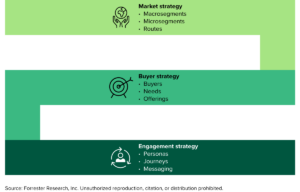Go-To-Market Strategy: Three Steps To Intentional Segmentation And Route-To-Market Decisions
A one-size–fits–all go–to–market strategy is nonexistent. But B2B organizations do need a methodology in place to support the creation of an audience–focused go–to–market strategy. The Forrester Go-To-Market Architecture is a comprehensive decision-making framework for evaluating different go–to–market options and choosing what is most viable for your organization. Delivering desired results requires a cascading set of decisions across three strategic layers: market, buyer, and engagement.

The market strategy layer guides B2B leaders on how to make decisions about segmentation and routes to market. Senior leadership teams must identify which market segments to consider, prioritize those segments, and determine the most effective routes to those markets. It’s a difficult task, especially when there are differing opinions that may exist across sales, marketing, and product leaders. Leaders should work methodically through the three steps below to develop an insights–driven and aligned go–to–market strategy.
Step 1: Identify Which Market Segments To Consider
Market segment identification requires leaders to work together and determine what segmentation options are ideal for their business. Macrosegmentation, such as geographic and firmographic criteria, is a conventional method used by many organizations to group segments broadly. You may need to employ microsegmentation methods if further granularity is required to be more effective with a particular audience. Microsegment criteria can include technographic, psychographic, or sociographic.
Step 2: Prioritize Segments With The Highest Propensity To Succeed
At any given time, certain market segments may be more attractive than others. B2B leaders need an insights–driven approach to determining which segments should be prioritized — removing any opinions or biases that may exist — to identify the most viable and attractive segments as targets for their business. Without focus, it is impossible for go-to-market execution teams to be effective.
Step 3: Determine Ideal Routes To Market
B2B leaders often overlook routes-to-market decisions in early strategy discussions. It’s an important element of GTM strategy, especially since a mix of routes will likely be needed to satisfy B2B buyer expectations. In fact, more than one-third (38%) of global purchase influencers indicated that they used a digital transaction method for either their initial or renewal purchase, according to Forrester Buyers’ Journey Survey, 2023. B2B organizations have two primary route–to–market choices: direct and indirect. But there are many ways to reach particular market segments, such as online marketplaces, resellers, or e-commerce sites. Find the right balance of direct and indirect routes to market based on the preferences and behaviors of your target audience.
What happens if B2B leaders don’t follow these steps? Revenue teams become overwhelmed, attempting to reach and engage everyone. Resources (both people and budgets) are spread too thin, and revenue goals are missed. The truth is that targeting more markets and chasing more opportunities does not necessarily equate to more growth. B2B leaders must focus and prioritize the ideal market segments and routes to market as the first step in developing their go-to-market strategy.
This is the first of a three-part series on go-to-market strategy. Forrester clients interested in learning more about the Forrester Go-To-Market Architecture can click here to access the research report. If you enjoyed this post and want to connect, you can find me on LinkedIn!
